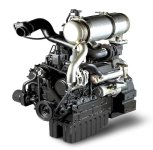A warmer T-stat does not restrict flow once opened. A warmer T-stat begins to open at a higher temperature. As an example an engine builds up some heat, enough to cause the T-stat to begin to open, and then once the T-stat starts to open, the engine is stuck at that initial opening temperature until the entire cooling system gets enough heat into to open up the T-stat further. A warmer T-stat does not begin opening up until a warmer temperature, but once the T-stat begins opening, the engine is stuck at that temperature until the rest of the coolant warms up beyond the T-stat's initial opening temperature. An engine that takes 20 minutes to come up to temperature has too much coolant flow. Restricting the coolant flow with a higher temperature T-stat will shorten to warm-up time.
An important point from the pushback: A warmer T-stat does not restrict coolant flow of a warmed up engine. Electric coolant fans tend to kick on from 220°F to 235°F (remember pressurized coolant systems have a higher boiling point) and then draw engine temps down to 180°F to 205°F before kicking off. Since the little three cylinder in the NX6010 uses a thermal fan clutch (tfc), a tfc can be expected to kick on around 170°F ambient radiator temps, which are a good 30°F cooler than the actual coolant temperature. A higher T-stat can increase the cycling of an electric cooling fan but is unlikely to change the tfc performance that much. Notwithstanding, since we do not want to increase coolant fan cycling, a good tech will, if not already known, measure the actual temps of the T-stat opening and the engine cooling fan kicking clutch on and off and, if needed, select a T-stat with a higher temperature but one that is below the temperature the cooling fan kicks on. If the engine is warming up at or above 165°F (ish) and just reading low on the meter or gauge on the dash, then I would not horse around swapping T-stats.
In so far as the heater goes, in this class I'm under the impression since I did not notice any heater lines (not that I was really looking) that these tractors use a heating element, not engine coolant to heat the cabs. A heating element should not care what temperature the engine is at but will take awhile to come up to temperature because of low ambient air temperature, and relatively low wattage available from the alternator at idle.
<img src="http://www.tractorbynet.com/forums/attachment.php?attachmentid=369156"/>
